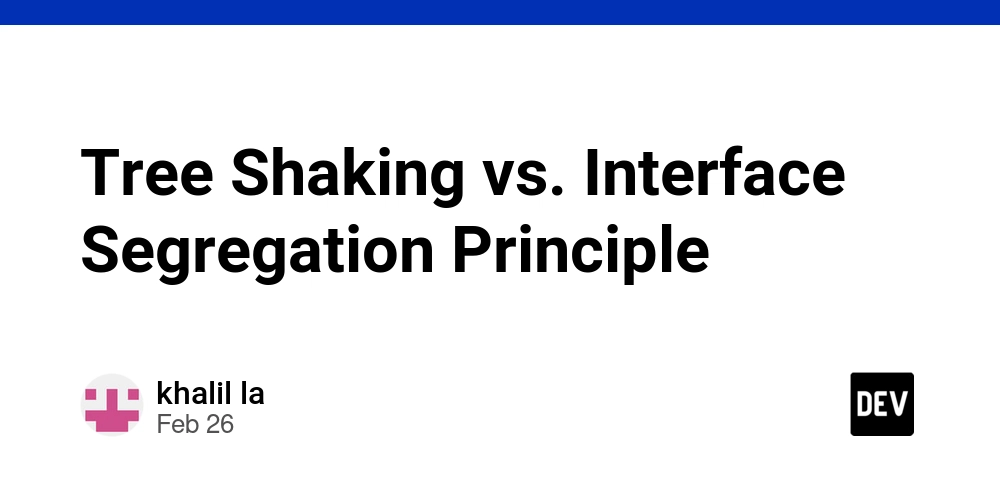Tree Shaking vs. Interface Segregation Principle
Tree shaking and the Interface Segregation Principle (ISP) are concepts from different areas of software development, but both aim to reduce unnecessary code usage. Tree Shaking (Front-end/JavaScript Optimization) Definition: Tree shaking is a process used in JavaScript bundlers (like Webpack, Rollup, and ESBuild) to eliminate unused code from the final bundle. Purpose: Reduces the final file size by removing dead (unused) code. How It Works: Relies on ES6 module imports/exports (import/export). Analyzes which functions, classes, or variables are actually used in the project. Eliminates unused code to optimize performance. Example: // utils.js export function usedFunction() { console.log("I am used"); } export function unusedFunction() { console.log("I am not used"); } // index.js import { usedFunction } from "./utils"; usedFunction(); // "unusedFunction" is not imported, so it will be removed during tree shaking. Use Case: Web applications that need to minimize bundle size for faster loading. Interface Segregation Principle (ISP) (SOLID Design Principle) Definition: ISP is one of the SOLID principles in object-oriented programming (OOP). It states that a class should not be forced to implement interfaces it does not use. Purpose: Avoids bloated interfaces and ensures that classes only depend on relevant functionality. How It Works: Instead of a single large interface, break it into smaller, more specific ones. Classes only implement the interfaces they need. Example (Bad vs. Good Design in TypeScript/Java): // Bad Design: A single interface forcing all implementations to have unnecessary methods interface Worker { work(): void; eat(): void; } class Robot implements Worker { work() { console.log("Robot working"); } eat() { throw new Error("Robots don’t eat"); } // Violates ISP } // Good Design: Separate interfaces interface Workable { work(): void; } interface Eatable { eat(): void; } class Human implements Workable, Eatable { work() { console.log("Human working"); } eat() { console.log("Human eating"); } } class Robot implements Workable { work() { console.log("Robot working"); } // No unnecessary "eat" method } Use Case: Clean architecture and maintainable OOP code, especially in large applications. Key Differences Feature Tree Shaking Interface Segregation Principle Domain JavaScript bundling Object-Oriented Design Purpose Remove unused code to optimize performance Reduce dependency on unnecessary methods Concerned With Eliminating dead code Creating small, focused interfaces Example Technology Webpack, Rollup, ESBuild TypeScript, Java, C# (OOP languages) Goal Smaller bundle size Better code maintainability Conclusion Tree shaking helps front-end developers optimize performance by eliminating dead code. ISP helps OOP developers write cleaner, modular code by ensuring classes only implement what they need. Both concepts aim to reduce unnecessary code, but in different contexts—tree shaking for bundling, ISP for OOP design.

Tree shaking and the Interface Segregation Principle (ISP) are concepts from different areas of software development, but both aim to reduce unnecessary code usage.
Tree Shaking (Front-end/JavaScript Optimization)
- Definition: Tree shaking is a process used in JavaScript bundlers (like Webpack, Rollup, and ESBuild) to eliminate unused code from the final bundle.
- Purpose: Reduces the final file size by removing dead (unused) code.
-
How It Works:
- Relies on ES6 module imports/exports (
import/export). - Analyzes which functions, classes, or variables are actually used in the project.
- Eliminates unused code to optimize performance.
- Relies on ES6 module imports/exports (
- Example:
// utils.js
export function usedFunction() { console.log("I am used"); }
export function unusedFunction() { console.log("I am not used"); }
// index.js
import { usedFunction } from "./utils";
usedFunction(); // "unusedFunction" is not imported, so it will be removed during tree shaking.
- Use Case: Web applications that need to minimize bundle size for faster loading.
Interface Segregation Principle (ISP) (SOLID Design Principle)
- Definition: ISP is one of the SOLID principles in object-oriented programming (OOP). It states that a class should not be forced to implement interfaces it does not use.
- Purpose: Avoids bloated interfaces and ensures that classes only depend on relevant functionality.
-
How It Works:
- Instead of a single large interface, break it into smaller, more specific ones.
- Classes only implement the interfaces they need.
- Example (Bad vs. Good Design in TypeScript/Java):
// Bad Design: A single interface forcing all implementations to have unnecessary methods
interface Worker {
work(): void;
eat(): void;
}
class Robot implements Worker {
work() { console.log("Robot working"); }
eat() { throw new Error("Robots don’t eat"); } // Violates ISP
}
// Good Design: Separate interfaces
interface Workable {
work(): void;
}
interface Eatable {
eat(): void;
}
class Human implements Workable, Eatable {
work() { console.log("Human working"); }
eat() { console.log("Human eating"); }
}
class Robot implements Workable {
work() { console.log("Robot working"); } // No unnecessary "eat" method
}
- Use Case: Clean architecture and maintainable OOP code, especially in large applications.
Key Differences
| Feature | Tree Shaking | Interface Segregation Principle |
|---|---|---|
| Domain | JavaScript bundling | Object-Oriented Design |
| Purpose | Remove unused code to optimize performance | Reduce dependency on unnecessary methods |
| Concerned With | Eliminating dead code | Creating small, focused interfaces |
| Example Technology | Webpack, Rollup, ESBuild | TypeScript, Java, C# (OOP languages) |
| Goal | Smaller bundle size | Better code maintainability |
Conclusion
- Tree shaking helps front-end developers optimize performance by eliminating dead code.
- ISP helps OOP developers write cleaner, modular code by ensuring classes only implement what they need.
- Both concepts aim to reduce unnecessary code, but in different contexts—tree shaking for bundling, ISP for OOP design.











































































































































































![[The AI Show Episode 142]: ChatGPT’s New Image Generator, Studio Ghibli Craze and Backlash, Gemini 2.5, OpenAI Academy, 4o Updates, Vibe Marketing & xAI Acquires X](https://www.marketingaiinstitute.com/hubfs/ep%20142%20cover.png)




























































































































![[DEALS] The Premium Learn to Code Certification Bundle (97% off) & Other Deals Up To 98% Off – Offers End Soon!](https://www.javacodegeeks.com/wp-content/uploads/2012/12/jcg-logo.jpg)


![From drop-out to software architect with Jason Lengstorf [Podcast #167]](https://cdn.hashnode.com/res/hashnode/image/upload/v1743796461357/f3d19cd7-e6f5-4d7c-8bfc-eb974bc8da68.png?#)








































































































.png?#)























.webp?#)










_Christophe_Coat_Alamy.jpg?#)
 (1).webp?#)




































































































![Apple Considers Delaying Smart Home Hub Until 2026 [Gurman]](https://www.iclarified.com/images/news/96946/96946/96946-640.jpg)
![iPhone 17 Pro Won't Feature Two-Toned Back [Gurman]](https://www.iclarified.com/images/news/96944/96944/96944-640.jpg)
![Tariffs Threaten Apple's $999 iPhone Price Point in the U.S. [Gurman]](https://www.iclarified.com/images/news/96943/96943/96943-640.jpg)



































































































































